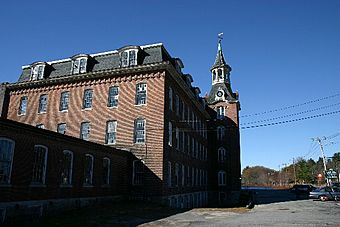Linwood Historic District (Northbridge, Massachusetts) facts for kids
Quick facts for kids |
|
|
Linwood Historic District
|
|

Linwood Cotton Mill
|
|
| Location | Northbridge, Massachusetts |
|---|---|
| Built | 1866 |
| Architectural style | Second Empire, Late Victorian |
| NRHP reference No. | 88002753 |
| Added to NRHP | June 16, 1989 |
The Linwood Historic District is a special area in Northbridge, Massachusetts. It's like a time capsule that shows what a busy factory town looked like long ago. This district includes the famous Linwood Cotton Mill and the homes where its workers lived. It was added to the National Register of Historic Places in 1989 because it's an important part of history.
Contents
The Linwood Historic District
A historic district is a special area. It has buildings, places, or objects that are important to history. These areas are protected to keep their history alive. The Linwood Historic District is in the village of Linwood. It is part of the town of Northbridge. This district is important because it shows how cotton mills and their towns used to be.
The Linwood Cotton Mill
The Linwood Mill was built in 1866. It was built by members of the Whitin family. They bought the land for the mill in the late 1840s. The Whitin family had been in the textile business for a long time. They started making textiles as early as 1809. The town of Whitinsville in Northbridge is even named after them.
At the time the Linwood Mill was built, the Whitin family owned almost all the textile factories in Northbridge. The Linwood Mill was made to process cotton. It produced different types of fabric. These included cambrics, sateens, and shirting fabric.
The first mill building was made of brick. It was about three and a half stories tall. Around 1870, the mill was made bigger. A steam power plant was added. This helped the mill make even more fabric. From the 1870s, only one other building from that time still stands. It is a brick storehouse.
Homes for Workers
The Linwood Mill complex was not just for making fabric. It also included homes for the people who worked there. The district has a beautiful home for the mill owner. It also has a carriage house and a greenhouse.
Many other types of homes were built by the Whitins. These included tenement houses and dormitories. There were also duplexes. These homes were built to house the factory workers.
Why Linwood is Special
The Linwood Mill complex is very well-preserved. Many other mills built by the Whitin family have changed a lot. Some were even damaged or destroyed by fire. But the Linwood complex still looks much like it did long ago. This makes it a great example of an old New England mill town.



